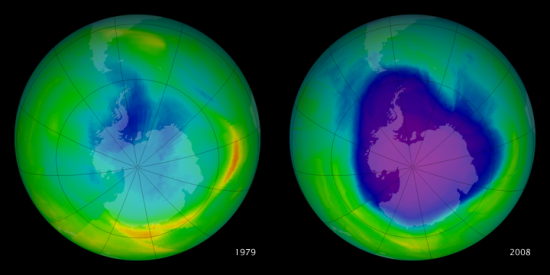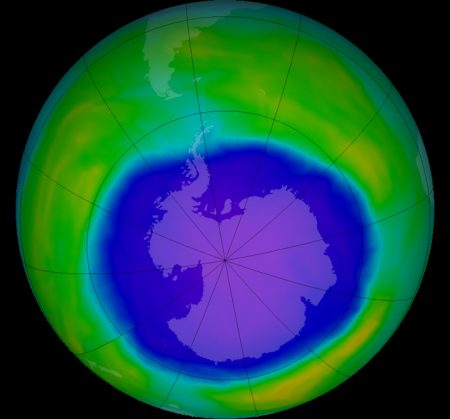May 16, 2018 – Back in 1987 the nations of the world signed an agreement in Montreal to eliminate chlorofluorocarbons (CFCs) in all products. They did this because two holes had opened in the ozone layer near the poles allowing raising the possibility of increased rates of skin cancer worldwide. Levels of CFC immediately began to decline by 50% in subsequent years while the ozone holes shrank to a point where some almost completely closed.
That is until recently when suddenly one form of CFC, CFC-11, saw levels of the pollutant begin to climb starting in 2012. Today CFC-11 levels are 25% higher despite the ban on the chemical worldwide. The signatories to the Montreal agreement annually report all CFC production. But it appears someone is lying or cheating. In today’s Washington Post, Durwood Zaelke, from the Institute for Governance and Sustainable Development states, “There’s some slight possibility there’s an unintentional release, but … they make it clear there’s strong evidence this is actually being produced.”
The Post’s report is based on a report published today in the international journal of science, Nature, which includes atmospheric observations from Hawaii indicating that the source of the CFCs may be somewhere in eastern Asia with the amount being added to the atmosphere equaling 13 million kilograms (more than 14,000 US tons annually. That may not sound like a lot when compared to greenhouse gas emission volumes, but it doesn’t take a lot of CFC-11 to seriously degrade ozone.
The evidence appears to indicate a new emissions source sufficient in quantity to show up in statistical atmospheric observation. The volumes being added are greater than the amount of decline in CFC presence from the disappearance in the chemical’s use.
Furthermore, because CFC-11 doesn’t degrade quickly, lasting up to 50 years once released, the accumulations over time will be sufficient in quantity to do more than damage the ozone layer. The chemical will, as a greenhouse gas, also contribute to atmospheric warming.
Someone needs to fess up. If not the signatories to the Montreal agreement will have to begin flying in the stratosphere to pinpoint the source. Even so the damage already being done will linger throughout the 21st century and beyond.
Could an increase in CFC-11 in the stratosphere be associated with a natural occurrence?
No. CFCs are artificial chemicals concocted in laboratories and were used in foam, fire retardant materials, and HVAC systems when first invented.
Could the CFC-11 come from old materials, from decommissioned utilities, or demolition of old manufacturing and building sites?
Unlikely because of the volume and rate of growth.
Is the release of new volumes of CFC-11 a violation of international law?
Undoubtedly. Any unreported production of CFC-11 within the Montreal Protocol outside of agreed to exceptions is considered a violation of international law.
What’s the potential punishment for the CFC-11 producer?
The Montreal Protocol included no punitive clauses. That means the finding of the CFC source and its exposure becomes vital. Exposed to the world as a CFC cheater may be sufficient to get the violators to stop. Otherwise, international forums such as the United Nations’ or World Trade Organization may have to act to apply sanctions on the violators.










